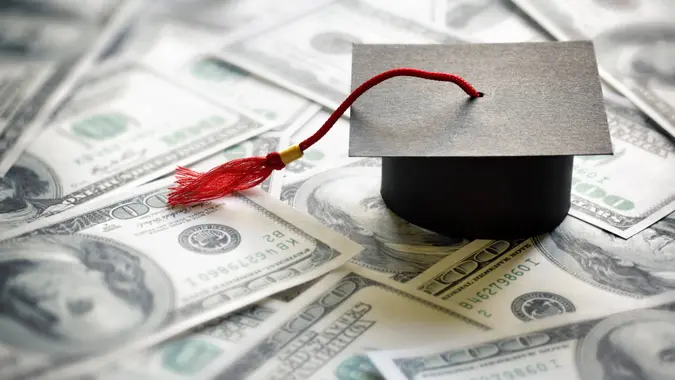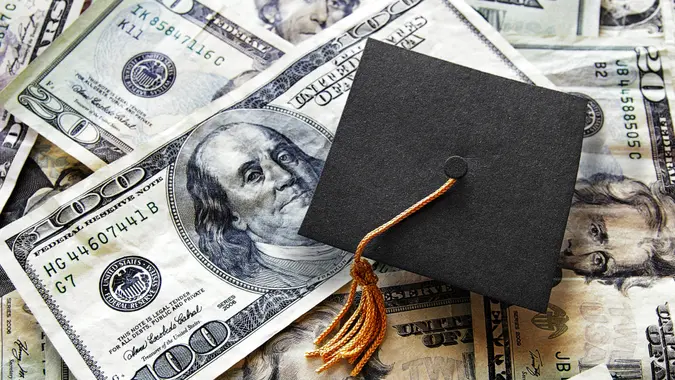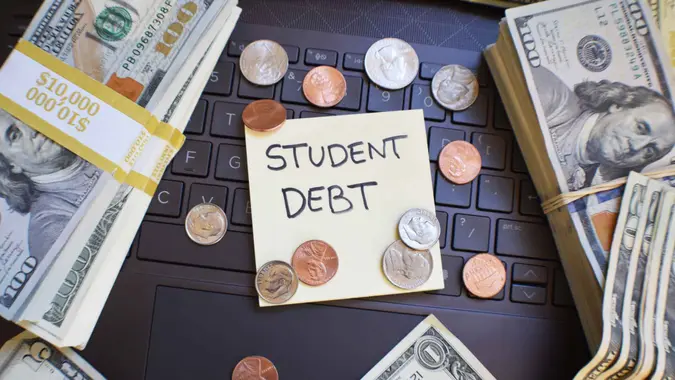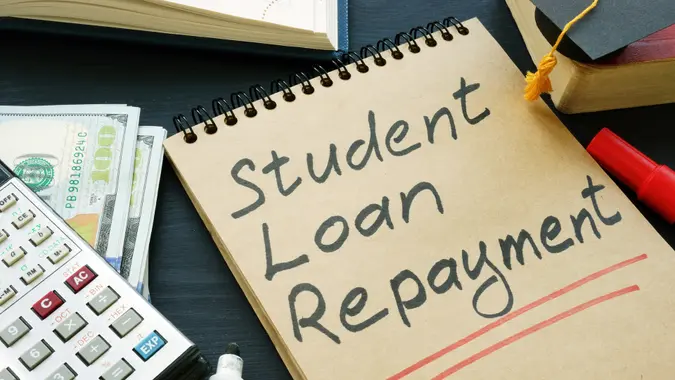US To Collect on Defaulted Student Loans — Can Your Wages Be Garnished?

Commitment to Our Readers
GOBankingRates' editorial team is committed to bringing you unbiased reviews and information. We use data-driven methodologies to evaluate financial products and services - our reviews and ratings are not influenced by advertisers. You can read more about our editorial guidelines and our products and services review methodology.

20 Years
Helping You Live Richer

Reviewed
by Experts

Trusted by
Millions of Readers
Student loan borrowers who have been holding out hope for student loan forgiveness will have their hopes dashed as of May 5, when the Department of Education (DOE) plans to report all borrowers who are in default on their loans to the Treasury Offset Program. That is essentially a collections agency run by the Treasury.
What this means, according to Leslie H. Tayne, Esq, finance and debt expert, head attorney and founder of Tayne Law Group, is that those in default “can have part of their Social Security benefits withheld, their tax refunds seized and their wages garnished.”
Roughly 5 million borrowers will be impacted, she explained. “The DOE has said that later this summer it will start sending notices regarding wage garnishment,” Tayne said.
Here’s more information about wage garnishment.
What Is Wage Garnishment?
According to the U.S. Department of Labor (DOL), wage garnishment is a legal procedure where a portion of a person’s income can be withheld to pay off a debt. While most such garnishments are determined in a court, federal agencies such as the DOE can also make such determinations.
Changes to Repayment Plans
Between ongoing litigation surrounding the Biden administration’s Saving on a Valuable Education (SAVE) plan and proposed changes to repayment plans and programs, nothing may seem certain for student loan borrowers right now, according to Igor Roitburg, a former attorney and current managing director at Stretto.
“The good news is consolidation and income-driven repayment (IDR) applications are available once again,” Roitburg said.
Other options for borrowers include income-based repayment (IBR), pay-as-you-earn (PAYE) and income-contingent repayment (ICR) plans. “Borrowers should still be able to enroll in these plans but will likely experience processing delays,” he explained.
What To Do If You’re in Default
As the DOE has not laid out any exceptions to its rule, if you’re in default, you should act as soon as possible, Roitburg said.
You generally have two options if you’re in default: Enroll in an income-driven repayment plan or consolidate your loans, Tayne explained. “You can also try paying off your loan in full, but this is unrealistic for most people.”
With loan rehabilitation, a borrower must reach out to the loan holder and agree to make nine monthly payments within 20 days of the due date for 10 consecutive months, Tayne said.
Consider Loan Consolidation
Another option is loan consolidation, but this isn’t necessarily always more affordable, Tayne said. “Consolidation combines all of your loans into a single balance, so you pay more interest over time.”
There are two ways to consolidate your defaulted loans. You can opt for an income-driven repayment plan — where your payments are based on a percentage of your discretionary income — or you can make three back-to-back payments on a defaulted loan before you consolidate, she said.
What About Bankruptcy?
For people who hope to file for bankruptcy to get around wage garnishment, while it may mean that creditors and collections agencies cannot collect debt or garnish your wages, Tayne urged people thinking about this to consult with a lawyer first.
“Federal student loans aren’t automatically discharged in bankruptcy, so you would need to file a separate action and then show the court that repaying your loan would cause undue hardship,” she said.
Defining Undue Hardship
In 2018, the first Trump administration issued a request for information (RFI) to help better define how “undue hardship” cases are determined when borrowers attempt to discharge student loans during bankruptcy, Roitburg explained.
Building on the RFI, on Nov. 17, 2022, the Biden-led DOJ issued new guidance on how the DOJ would process actions to discharge federal student loans in bankruptcy, he explained. This led to “a more streamlined, objective and cost-effective process which has resulted in thousands of borrowers achieving discharges.”
Prior to the guidance, it was nearly impossible to discharge student loans in bankruptcy, Roitburg said.
“With the guidance, debtors are successfully achieving discharges in approximately 85% of cases. The current Trump administration appears to have reviewed the guidance and signaled to the DOJ that discharges under the guidance may proceed.”
While that is great news, Tayne urged borrowers to keep in mind that if the court doesn’t rule in your favor, you could still be on the hook for the loans.
Get Out of Default ASAP
The short of this is that federal student loan borrowers who are in default should do what they can to get out of default as quickly as possible through consolidation or rehabilitation.
“Borrowers will no longer be able to simply ignore student debt. Borrowers will need to take some action,” Roitburg said.
More From GOBankingRates
Sources
- Leslie H. Tayne, Esq, Tayne Law Group
- Igor Roitburg, Stretto
 Written by
Written by  Edited by
Edited by 
























